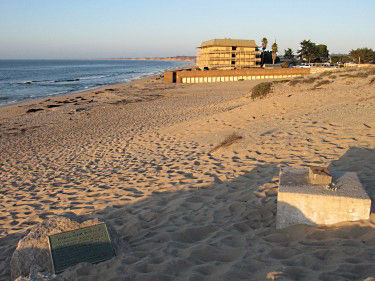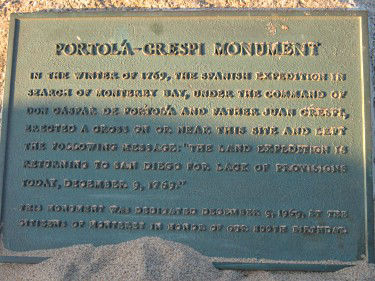On the morning of September 19th, 2009, users of Monterey's shoreline recreation trail were dismayed to find that a twenty foot redwood cross, which stood on Del Monte Dunes near the Monterey Beach Resort (as the hotel was then known), had been cut down by vandals during the night. What began as a simple crime quickly became a constitutional crisis that sharply divided the community.

The crime scene.

Explanatory plaque. Click to enlarge.
When the story broke, it also came to light that the American Civil Liberties Union was in the process of challenging the legality of the cross because it was on city property. A heated debate immediately followed. While everyone agreed that vandalism should not be tolerated, there remained the question of what to do next. Should the cross be repaired, moved to private property, or left to rot somewhere out of public view?
On October 7th the Monterey City Council voted to replace the cross, with the stipulation that a legal defense fund of $50,000 be established with private donations before proceeding. Many were outraged by this decision, and as many people praised it. Some were of the opinion that the city had no business promoting a religious symbol on public property, citing constitutional principles of separating church and state. Others felt the ACLU's grievance was petty, and that a cross was a beautiful symbol of faith.
Virtually lost in the shouting was the true meaning of this particular cross. Though many people on both sides recognized its local historic significance, most of these folks got the story wrong. This only added to the confusion over whether this was a secular or religious monument. The most popular misconception was that it marked the location where the Portola-Crespi expedition "landed" on the shores of Monterey Bay (hard to do, since it was a land expedition), and the cross was erected as part of their quest to spread Christianity.
What follows is the true story.
In 1602, the Spanish explorer Sebastian Viscaino sailed from Mexico up the coast of what was then known as Alta California. He brought back reports of a large bay with a natural harbor at its southern end. He felt that it's relative seclusion, and proximity to sources of timber made the site suitable for future colonization. Viscaino was not the first to sail here, for Juan Cabrillo had reported on this bay 60 years earlier. But Viscaino provided more detailed and glowing (some say, exaggerated) reports. He named the place after the viceroy who approved his expedition, the Count of Monte Rey.
Yet another century and a half passed before the Spanish got serious about colonizing Alta California. It wasn't until 1768 that another expedition from Mexico was planned. It had two goals. First, to establish a presidio (a fortified settlement) at San Diego, and second, to locate Monterey Bay and establish another presidio by the harbor described by Viscaino.
The San Diego settlement was established in the late Spring of 1769. Shortly thereafter a land expedition, a large group consisting of soldiers, natives, and pack mules, was assembled there. Led by Captain Don Gaspar de Portola and Father Juan Crespi, they began their march northward on July 14th. A supply ship from Mexico, the San Jose, was supposed to rendezvous with them when they reached Monterey Bay. Little did they know, the ship had already been lost at sea before they set out.
The expedition worked its way up the coast then turned inland near Morro Bay. They struggled over coastal mountains until they came upon what is now known as the Salinas River. However, they mistook it for the Rio del Carmelo (Carmel River) described by Viscaino. That was their first navigational mistake which caused confusion for the rest of their journey.
Viscaino accurately described the Carmel River as being south of Monterey Bay. So when the Portola-Crespi expedition arrived at the mouth of the Salinas River on October 1, 1769, they believed they were still south of their destination. After five days they continued north until they reached San Francisco Bay. By November 11th, realizing they had overshot their destination, they turned back south.
By now they were acutely aware that the navigational information left by Viscaino was woefully inadequate. Even worse, their provisions were running low and the San Jose was nowhere to be found.
On November 28th, the party stood on the southern shores of Monterey Bay, completely unaware that they had arrived at their destination. To their eyes it looked nothing like the bay described by Viscaino. In one last attempt, they marched a bit farther south, and camped for several days near San Jose Creek, unaware that they were just south of the actual Carmel River. Suffering from malnutrition and illness, the decision was finally made to return to San Diego.
On December 9th the group erected a large wooden cross on the shore near the campsite to signal passing ships, the San Jose in particular. A cross was chosen because it was easily constructed from available materials and would be readily identified by the ship's lookouts. Etched in the wood were instructions to dig at the base where a message was placed in a container. The message explained their situation and stated that they were returning to San Diego. A second cross was erected on the shore near the southeast side of Monterey Bay before heading back to their San Diego base.
In April 1770 Portola and Crespi set out once again, this time with an understanding of their earlier navigational errors. They located Monterey on May 24th. They soon discovered that the second cross they had erected was still standing. Crespi reported in his journal that natives had placed a pile of mussels at the base, which was also surrounded by arrows stuck in the ground. Hanging from the cross was a string of "half fresh" sardines.
Meanwhile, Father Junipero Serra set sail aboard the supply ship San Antonio, arriving at Monterey on May 31st. The first Spanish settlers were in Monterey to stay.
In 1944 Harry Downie, who was in charge of the Carmel Mission restoration, raised a hand-made replica of Portola's first cross on a small hill overlooking the Carmel River lagoon, in honor of the expedition that camped nearby 175 years earlier. The site, which at the time was privately owned, became part of Carmel River State Beach in 1953. Downie's cross fell during a fierce storm in November 1983, and was promptly replaced by a group of local volunteers. A plaque at the base of the hill's south side explains the history behind the cross.
Downie also made second replica to commemorate the bicentennial of Monterey's founding. It was raised and dedicated at a public ceremony on December 9, 1969, exactly 200 years after Portola's men erected their second cross on the same shore. Hand made from locally grown redwood, it was anticipated that this cross would be durable enough to stand until the city's 300th birthday. A small explanatory plaque with the following inscription was mounted on a rock near it's base:
Forty years later this cross lay flat on the dune after a criminal's saw ripped through the wood at its base.
It does not appear that the cross will ever return to its proper, historically accurate location. Only about $5,000 was raised for the legal defense fund. After an initial surge of support, donations stopped coming in (probably because the fund was not promoted beyond the initial announcement). On February 26, 2010 it was decided that the fund would be abandoned and the donations would be returned to the contributors. The cross itself would be placed in a new home at San Carlos cemetery across Pearl Street from Dennis the Menace playground.
There are many legal and moral questions in this case that need clear answers:
In the absence of a proper judicial review of this case, these important questions remain unresolved to this day.
Website Builder Software